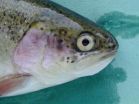Researchers advance biosynthesis of potent anti-cancer drug Taxol
New engineering approach unlocks metabolic pathway to yield new levels of taxadiene in E. coli
2010-10-01
(Press-News.org) MEDFORD/SOMERVILLE, Mass.--Researchers from Tufts University School of Engineering and MIT have reported a new way to biosynthesize important precursors to the potent anti-cancer compound Taxol in an engineered strain of E. coli bacteria.
The findings are significant steps on the way to achieving cost-effective, large-scale production of Taxol and the effort to design new Taxol-like pharmaceuticals.
The work is reported in the October 1, 2010, issue of the journal Science.
Taxol (paclitaxel) and its structural analogs are among the most powerful and commercially successful anticancer drugs, used to treat Kaposi's sarcoma and breast, lung and ovarian tumors.
Taxol was originally derived from the bark of the Pacific yew tree. Its anti-cancer properties were discovered more than 40 years ago.
But Taxol's power comes with an environmental price: Early stage production methods required sacrificing two to four fully grown trees for each patient. Alternative means of production – such as using needles rather than bark – still rely on slow, laborious plant-based processes. This limits production of Taxol itself and development of new derivatives that might be even more effective.
"This was the basis for our efforts to redirect biosynthesis through a simple, process-friendly bacterium like E. coli," explains Tufts' Blaine Pfeifer, Ph.D., assistant professor of chemical and biological engineering and co-corresponding author on the paper. "We faced a tremendous challenge because of the engineering needed first to 'equip' the E. coli cell to support Taxol biosynthesis and the subsequent protein engineering required to allow the first two steps in the Taxol biosynthesis scheme to be active within this new host."
The complex metabolic sequence that produces Taxol involves at least 17 intermediate steps and is not fully understood. The team's goal was to optimize production of the first two Taxol intermediates, taxadiene and taxadien-5alpha-ol.
The researchers partitioned the taxadiene metabolic pathway into two modules: the intracellular supply of substrates, or precursors, that must be present within the E. coli cell before Taxol can be produced (the upstream pathway) and the biosynthetic steps needed to make the first two Taxol intermediates (the downstream pathway).
This modular approach allowed manipulation of the many variables in each pathway to achieve the right balance to optimize production of the two intermediates. It effectively "unlocked" unprecedented production levels of early-stage Taxol intermediates through E. coli.
The team reported producing more than 1 gram of taxadiene per liter of production culture — a level that was 1,000 times greater than had previously been reported using E. coli as a host and 15,000 times more than the study's initial production levels prior to balancing the upstream and downstream modular pathways. For the first time, the second Taxol precursor, taxadiene-5alpha-ol, was produced from E. coli.
The researchers caution that significant work is still needed in order to complete the synthesis of a Taxol precursor suitable for commercial production and potentially replace the current plant-based production process with a more efficient operation based upon microbial biosynthesis. Such an approach could also be applied to production of chemicals and fuels microbially derived from renewable resources.
"Though this is only a first step, it is a very promising development and certainly supports this approach and its potential," said Pfeifer.
INFORMATION:
Research support came from the Singapore-MIT Alliance, National Institutes of Health and a Milheim Foundation Grant for Cancer Research.
Isoprenoid Pathway Optimization for Taxol Precursor Overproduction in Escherichia coli, P.K. Ajikumar; W.-H. Xiao; K.E.J. Tyo; Y. Wang; F. Simeon; E. Leonard; O. Mucha; T.H. Phon; B. Pfeifer; G. Stephanopoulos, Science, October 1, 2010.
Tufts University School of Engineering is dedicated to educating the technological leaders of tomorrow. Located on Tufts' Medford/Somerville campus, the School of Engineering offers a rigorous engineering education in an environment characterized by the best blending of a liberal arts college atmosphere with the intellectual and technological resources of a world-class research university. Close collaboration with the School of Arts and Sciences and the university's extraordinary collection of excellent professional schools creates a wealth of educational and research opportunities. The School of Engineering's primary goal is to educate engineers committed to the innovative and ethical application of technology in the solution of societal problems. It also seeks to be a leader among peer institutions in targeted areas of interdisciplinary research and education that impact the well-being and sustainability of society, including bioengineering, sustainability and innovation in engineering education.
Tufts University, located on three Massachusetts campuses in Boston, Medford/Somerville and Grafton, and in Talloires, France, is recognized among the premier research universities in the United States. Tufts enjoys a global reputation for academic excellence and for the preparation of students as leaders in a wide range of professions. A growing number of innovative teaching and research initiatives span all Tufts campuses, and collaboration among the faculty and students in the undergraduate, graduate and professional programs across the university's schools is widely encouraged. END
ELSE PRESS RELEASES FROM THIS DATE:
2010-10-01
Chestnut Hill, Mass. (9/30/2010) – Scientists have sequenced the genome of the Southern house mosquito, providing new insights into the most diverse and widespread of three groups of disease-bearing mosquitoes and shedding new light on the transmission of mosquito-borne diseases such as malaria, encephalitis, West Nile virus and filariasis, international teams of researchers report in the upcoming edition of the journal Science.
Breeding in drains, cesspools and other polluted water bodies, Culex quinquefasciatus feeds on blood from birds, livestock and humans and transmits ...
2010-10-01
Ethnicity is a contributing risk factor of cardiovascular problems in kidney recipients of South Asian origin post-transplant, according to a study appearing in an upcoming issue of the Clinical Journal of the American Society Nephrology (CJASN).
South Asians comprise 25% of all Canadian visible minorities and have a higher risk for cardiovascular disease in the general population. However, the risk of cardiovascular events has never been studied in this minority population.
To investigate, G.V. Ramesh Prasad, MBBS, MSc, FRCPC, FACP, FASN (University of Toronto) and ...
2010-10-01
A North Carolina State University researcher is part of a team that has discovered fossilized feathers from a giant penguin that lived near the Equator more than 36 million years ago. These feathery fossils reveal color patterns in an ancient extinct penguin species, and offer clues to how modern penguin feathers evolved.
The penguin in question – dubbed Inkayacu paracasensis, or Water King – dates from the late Eocene period and stood almost five feet tall. The fossil was discovered near the Paracas Reserve, located along the eastern coastline of Peru. A research team ...
2010-10-01
COLUMBIA, Mo.– It might seem obvious that a dinosaur's leg bone connects to the hip bone, but what came between the bones has been less obvious. Now, researchers at the University of Missouri and Ohio University have found that dinosaurs had thick layers of cartilage in their joints, which means they may have been considerably taller than previously thought. The study is being published this week in the journal PLoS ONE (Public Library of Science).
"Our study of the limbs of modern-day relatives of dinosaurs shows that dinosaurs were significantly taller than original ...
2010-10-01
CAMBRIDGE, Mass. -- MIT researchers and collaborators from Tufts University have now engineered E. coli bacteria to produce large quantities of a critical compound that is a precursor to the cancer drug Taxol, originally isolated from the bark of the Pacific yew tree. The tree's bacteria can produce 1,000 times more of the precursor, known as taxadiene, than any other engineered microbial strain.
The technique, described in the Oct. 1 issue of Science, could bring down the manufacturing costs of Taxol and also help scientists discover potential new drugs for cancer and ...
2010-10-01
1st October 2010 - The Culex quinquefasciatus mosquito poses a significant threat to human health as a blood-sucking transmitter of elephantiasis-causing worms and encephalitis-inducing viruses. An international team of scientists, including researchers from the University of Geneva and the SIB Swiss Institute of Bioinformatics sequenced its genome and studied its responses to pathogen infections. Two articles published in today's issue of Science, describe results from comparing the Culex mosquito with the malaria mosquito, Anopheles gambiae, and the dengue mosquito, Aedes ...
2010-10-01
The role of a key nutrient which prevents cataracts in salmon has been revealed by eye specialists at the University of East Anglia.
Research published today in the American Journal of Physiology - Regulatory, Integrative and Comparative Physiology shows how the nutrient histidine, when added to the diet of farmed salmon, stops cataracts (clouding of the lens in the eye) from forming.
Following fears over BSE in the early 1990s, blood meal was removed from the diet of farmed salmon. This coincided with a large increase in the incidence of cataracts which cause economic ...
2010-10-01
CAMBRIDGE, Mass. -- When it comes to intelligence, the whole can indeed be greater than the sum of its parts. A new study co-authored by MIT, Carnegie Mellon University, and Union College researchers documents the existence of collective intelligence among groups of people who cooperate well, showing that such intelligence extends beyond the cognitive abilities of the groups' individual members, and that the tendency to cooperate effectively is linked to the number of women in a group.
Many social scientists have long contended that the ability of individuals to fare ...
2010-10-01
TORONTO, Ont., September 30, 2010 — South Asian men and women have more than twice the risk of suffering a heart attack after a kidney transplant, according to a study led by St. Michael's nephrologist Dr. Ramesh Prasad.
The study, published today in the Clinical Journal of the American Society of Nephrology, studied 864 patients who underwent a transplant between 1998 and 2007. Researchers analyzed and compared the group's risk for a heart attack, angioplasty and bypass surgery rates, and death from heart disease after a kidney transplant with Caucasian, black and East ...
2010-10-01
Women in South Africa who underwent human papillomavirus (HPV) DNA-based testing or visual inspection of the cervix followed by treatment of test-positive women with cryotherapy had a statistically significant reduction in high grade cervical cancer precursors, compared with women in a control group, according to a study published online Sept. 30 in The Journal of the National Cancer Institute.
In many developing countries, especially in sub-Saharan Africa, cytology-based screening is unavailable. To counter this lack of availability, non-cytological screening methods ...
LAST 30 PRESS RELEASES:
[Press-News.org] Researchers advance biosynthesis of potent anti-cancer drug Taxol
New engineering approach unlocks metabolic pathway to yield new levels of taxadiene in E. coli

